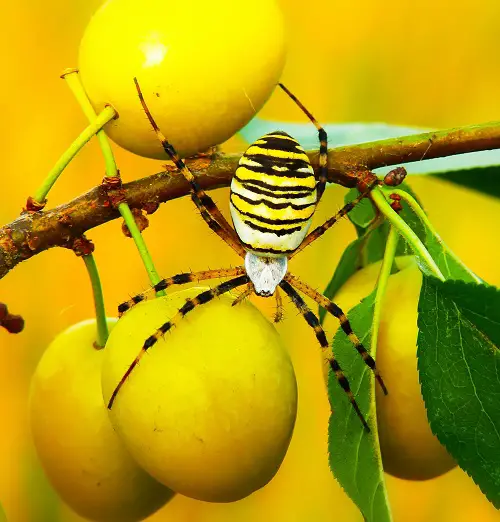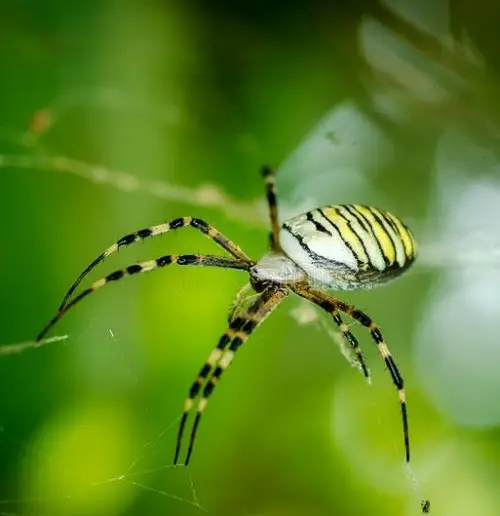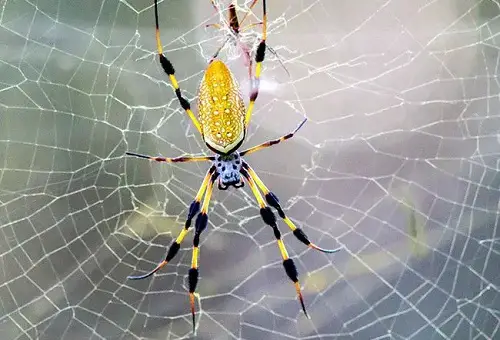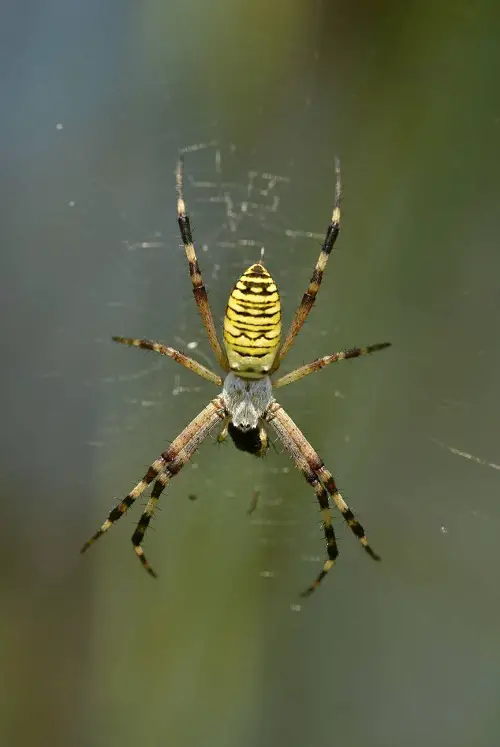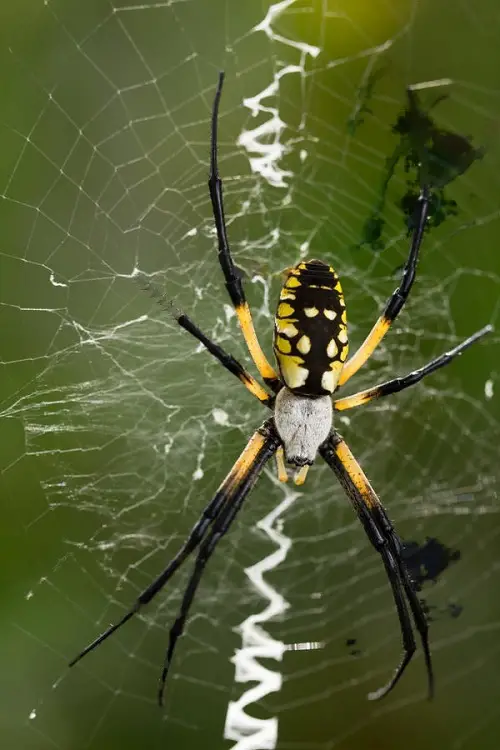Are your surroundings filled with banana Spiders? Here is our article to learn amazing Banana Spider Facts and how to get rid of them.
Also popular as the Brazilian wandering spider, the Banana Spider is a venomous spider that can be found in parts of Central and South America. Its venom can cause severe pain, muscle spasms, and other issues. If you have these creatures around and you have to get rid of them, we have all the details!
Learn how to get rid of spider mites
What is a Banana Spider?
The Banana Spider is a large arachnid species common in tropical and subtropical regions of the world. They have a unique yellow or golden coloration and the ability to weave strong and intricate webs.
The Banana Spider is a type of orb weaver spider, and like other species in this family, it spins circular webs that are among the strongest of all spider webs.
Banana Spider Size
It is a large spider, with females measuring up to 5 inches (12.7 cm) in length, including their legs. Male Banana Spiders are much smaller, typically measuring less than half the size of females.
These spiders are common in trees, gardens, homes, and other structures. These spiders are most active at night and are also relatively docile, rarely biting unless you provoke them.
Banana Spider Bite
Banana Spider bite contains venom, which is a potent neurotoxin that can cause various symptoms. If bitten by a Banana Spider, it is essential to seek medical attention immediately.
In some cases, the bite can be life-threatening, especially if the victim is a child or has a pre-existing medical condition.
To reduce the risk of a Banana Spider bite, it is best to avoid handling or disturbing these spiders and to wear protective clothing when working or hiking in areas where they are known to live.
Is Banana Spider Poisonous?
Yes, the Banana Spider is poisonous, but it is not a significant threat to humans. The venom of the Banana Spider is not as potent as that of other spider species, such as the Black Widow or Brown Recluse.
It is important to note that while Banana Spiders are generally not aggressive toward humans, they may become defensive if they feel threatened.
Look at the Pink Spiders Around the World
How Does Banana Spider Bite Feel Like?
A bite from a Banana Spider can feel different for each person depending on various factors, such as the amount of venom injected and the individual’s sensitivity to the venom.
Generally, a Banana Spider bite can cause intense pain that spreads to other parts of the body, such as the limbs and torso. Some people may also experience muscle spasms, nausea, sweating, and difficulty breathing.
In severe cases, a Banana Spider bite can lead to paralysis, respiratory failure, and even death. It is crucial to seek medical attention immediately if you suspect that you have been bitten by a banana spider or any venomous spider.
What Do Banana Spiders Eat?
Banana Spiders feed on a variety of prey, including insects, other spiders, and small vertebrates. Their diet can vary depending on their size and location, but they are known to feed on a wide range of insects, such as crickets, grasshoppers, and cockroaches.
They can also eat other spiders, including tarantulas, and have been known to cannibalize their own species.
Banana spiders have been observed consuming small lizards, frogs, and rodents. Their diet is not limited to living prey, as they are also known to scavenge on dead animals and occasionally feed on nectar and fruit.
Banana Spider Facts
1. Native
Banana Spiders are native to Central and South America and are found in tropical rainforests, savannas, and urban areas.
They are commonly found in the forests and urban areas of Central and South America. They are also known as “wandering spiders” because they move around a lot and are not confined to one area.
2. Venomous
They are one of the most venomous spiders in the world. Banana Spiders are known for their highly toxic venom, which can cause serious harm to humans and animals.
3. Also called Brazilian wandering spiders
Banana Spiders are sometimes called Brazilian wandering spiders, as they are commonly found in Brazil.
4. Named after Banana Plant
Banana Spiders are named after the banana plant because they are often found in banana plantations.
5. Big Size
They are large spiders with a leg span of up to 6 inches. Banana Spiders are one of the largest spiders in the world, with a leg span that can reach up to 6 inches.
6. They are Hunters
They are active hunters and use their venom to immobilize prey. Banana Spiders are active hunters that use their venom to immobilize prey before feeding on it.
7. Aggresive if Threatened
They can be aggressive and will defend themselves if threatened. Banana Spiders are known for their aggressive behavior and will defend themselves if they feel threatened.
8. Unique Color
Banana Spiders have a unique coloration that ranges from yellow to dark brown. This coloration serves as camouflage against predators and allows them to blend in with their surroundings.
9. Powerful Bite
Banana Spiders have a powerful bite, but their venom is not harmful to humans. However, their bites can cause mild pain and swelling.
10. Strong Silk
They are known for their incredibly strong silk, which is stronger than steel of the same diameter. This silk is used to create their webs, which can span up to three feet in diameter.
11. Size of Female Banana Spiders
Female Banana Spiders are much larger than males and can grow up to two inches in body length. Males are only about a quarter or half of the size of females.
12. Not Aggressive to Humans
Banana Spiders are not aggressive toward humans and will typically only bite if they feel threatened or cornered.
13. Nocturnal Hunters
These spiders are nocturnal hunters and will typically build their webs in areas where prey is likely to be abundant, such as near streetlights or over bodies of water.
14. Eggs
Female Banana Spiders are able to produce up to seven egg sacs in a single season, each containing hundreds of eggs.
15. Research
The silk of Banana Spiders has been studied for its potential use in creating high-strength materials, such as bulletproof vests.
16. Important for the Ecosystem
Banana Spiders are important predators in their ecosystems, feeding on a variety of insects and other arthropods. They play an important role in controlling pest populations and maintaining a healthy balance in their environments.
Read about Lifespan of Jumping Spider
How to Get Rid of Banana Spiders
1. Remove Cobwebs
Banana Spiders create cobwebs to catch prey. By regularly removing cobwebs in and around your home or yard, you can disrupt their hunting patterns and discourage them from building webs in those areas.
2. Use Peppermint or Lavender
Banana Spiders don’t like to be around certain scents, such as peppermint and lavender. Spray essential oils around the area where you spot them.
3. Use White Vinegar
White vinegar is a natural cleaning solution that can also repel Banana Spiders. Simply mix equal parts white vinegar and water in a spray bottle and apply it to areas where spiders are found. The strong scent of vinegar can be effective in repelling spiders.
4. Use Insecticides
While insecticides can be effective in killing Banana Spiders, they can also be harmful to other living creatures and the environment. Therefore, it’s important to use caution when using insecticides and to follow the manufacturer’s instructions carefully.
5. Clean the Exterior of Your Home
Banana Spiders are attracted to clutter and debris. By regularly cleaning the exterior of your home, you can remove spider webs, egg sacs, and other debris that might attract spiders.
This can include sweeping or hosing down outdoor areas, removing piles of leaves or debris, and trimming back overgrown vegetation.
6. Seal Cracks and Crevices
Banana Spiders can enter your home through small cracks and crevices. By sealing these gaps with caulk or weatherstripping, you can prevent spiders from entering your home and creating webs.
7. Clean Frequently
Regular cleaning and vacuuming can remove Banana Spider webs and eggs, as well as eliminate sources of food for spiders, such as insects and other small arthropods.
8. Use Eucalyptus Oil
Spray eucalyptus oil around the area where you spot Banana Spiders. Its strong scent is very potent to keep them away. Learn How to Grow Eucalyptus Plants here
9. Remove the Feeding Source
Banana Spiders feed primarily on insects, so removing their food source may reduce the spider population in an area. However, this may not be a practical solution as it would require a significant reduction in the overall insect population in the area.
Additionally, Banana Spiders can survive for long periods without food, so removing their food source may not have an immediate effect on the spider population.
10. Professional Help
In any case, if you are experiencing banana spider infestation or have concerns about spider populations in your area, it is always best to seek the advice of a professional pest control company rather than attempt to deal with the situation yourself.
Joro Spider vs Banana Spider
The Joro spider is a large species of orb-weaver spider native to the tropics of India and Southeast Asia. It has a round abdomen and long, black legs.
Banana Spiders are a species of orb-weaver spider native to America. It is yellowish in color and has a distinctive yellow band on its abdomen.
Both species spin webs to catch their prey, but the Joro spider is larger and more aggressive than the banana spider.


